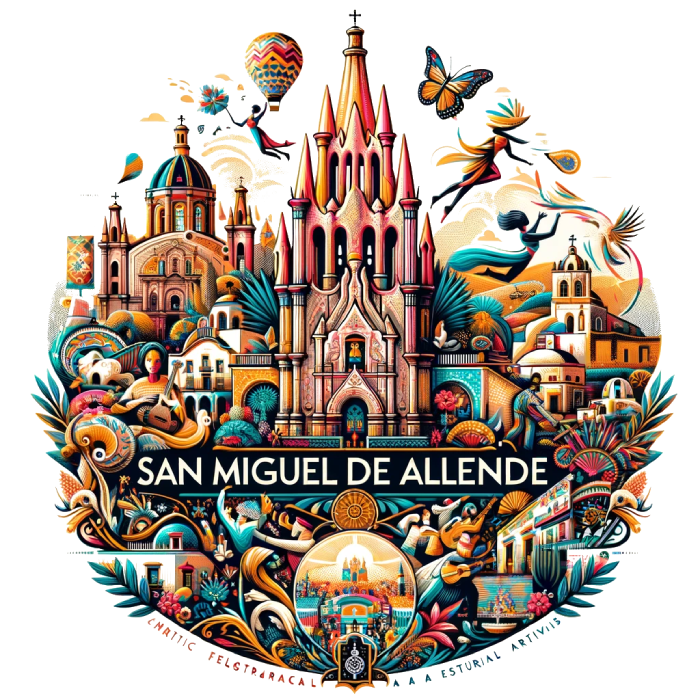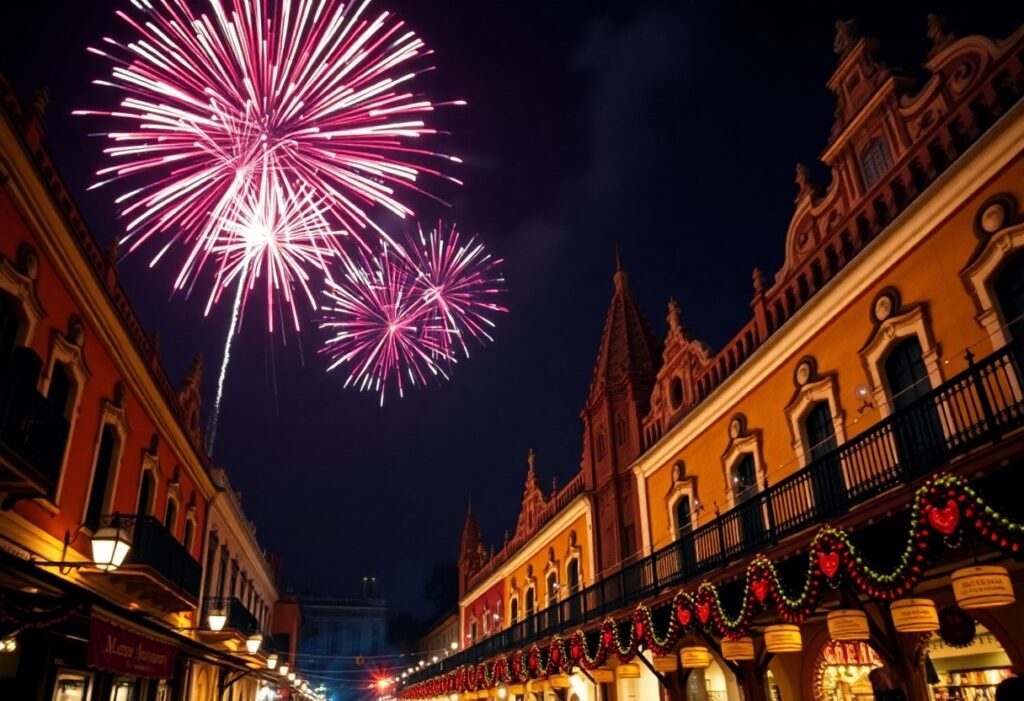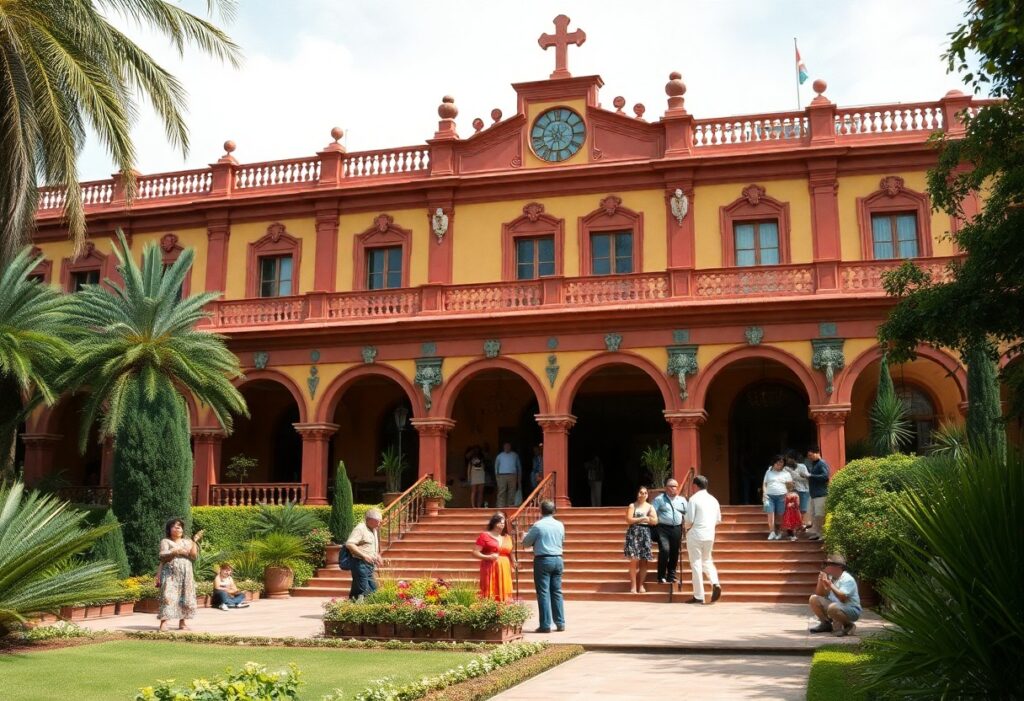San Miguel de Allende transforms into a vibrant spectacle during the Day of the Dead, and at its core stands La Catrina, a striking symbol of life, death, and Mexican heritage. Created in 1910 by José Guadalupe Posada as a satirical critique of Mexico’s elite, La Catrina has evolved into a beloved cultural icon. In San Miguel de Allende, you’ll see her everywhere—adorning ofrendas, parades, and faces painted in her likeness. She embodies the Mexican philosophy of embracing death as part of life, blending indigenous and Catholic traditions. Discover how La Catrina connects the living with the dead, making her a central figure in this deeply meaningful celebration.
The Origins of La Catrina
A symbol of both elegance and mortality, La Catrina originated in 1910 as a satirical lithograph by José Guadalupe Posada. Known initially as La Calavera Garbancera, she mocked Mexico’s elite who abandoned their indigenous roots for European customs. Her skeletal figure and ornate hat served as a reminder that, in death, social status holds no meaning. This powerful imagery has since become a cornerstone of Mexican culture, especially during the Day of the Dead celebrations in places like San Miguel de Allende.
José Guadalupe Posada and La Calavera Garbancera
If you explore the roots of La Catrina, you’ll find her beginnings in the work of José Guadalupe Posada. He created La Calavera Garbancera to critique the Mexican upper class, particularly those who imitated European styles while ignoring their own heritage. Posada’s skeletal figure, dressed in a fancy hat, became a symbol of equality in death, a theme that resonates deeply in Mexican culture and the Day of the Dead traditions celebrated in San Miguel de Allende.
The Satirical Critique of Mexican Society
One of the most striking aspects of La Catrina is her role as a social critic. Posada used her to highlight the hypocrisy of Mexico’s elite during the Porfirio Díaz era, a time marked by inequality and corruption. Her skeletal form, adorned in European-style clothing, served as a stark reminder that wealth and status are fleeting. This critique remains relevant today, as La Catrina continues to symbolize the unity of all people in the face of death.
A deeper look into the satirical critique reveals how La Catrina’s imagery challenged societal norms. Posada’s work targeted the corruption and inequality of the Díaz regime, which favored the wealthy while neglecting the poor. By portraying death as the great equalizer, La Catrina became a powerful tool for social commentary. Her transformation into a cultural icon, especially in San Miguel de Allende, reflects the enduring importance of this message, blending humor and reflection in the celebration of life and death.
![]()
Diego Rivera and La Catrina’s Transformation
While La Catrina began as a satirical figure, her transformation into a cultural icon was solidified by Diego Rivera. Rivera’s artistic vision elevated her from a critique of societal elitism to a symbol of Mexican identity, blending indigenous and European influences. His work ensured that La Catrina became a central figure in the celebration of Día de los Muertos, connecting her to themes of life, death, and heritage.
The Mural “Dream of a Sunday Afternoon in Alameda Park”
Rivera’s 1947 mural, “Dream of a Sunday Afternoon in Alameda Park,” features La Catrina prominently, standing alongside historical figures and a young version of himself. This mural not only showcases her elegance but also ties her to Mexico’s rich history and cultural evolution. By placing her in this grand narrative, Rivera ensured her legacy as a symbol of unity and reflection on mortality.
Cementing La Catrina as a Cultural Symbol
The mural’s impact was profound, cementing La Catrina as a cultural symbol. Rivera’s portrayal of her in a historical context linked her to the broader Mexican identity, making her a figure of pride and reflection. Today, she represents the celebration of life and death, embodying the spirit of Día de los Muertos in San Miguel de Allende and beyond.
Afternoon celebrations in San Miguel de Allende often feature La Catrina as a central figure, her presence a reminder of the city’s deep cultural roots. Her transformation from satire to symbol highlights the resilience of Mexican traditions and the importance of honoring both life and death. Rivera’s mural ensured her place in history, making her an enduring icon of Mexican heritage and the vibrant festivities of Día de los Muertos.
What Does La Catrina Represent?
Some see La Catrina as a powerful symbol of equality, reminding us that death unites everyone, regardless of social status. She represents the Mexican embrace of mortality, blending humor, artistry, and reverence for the cycle of life and death. In San Miguel de Allende, her presence during Day of the Dead celebrations highlights the importance of honoring ancestors while celebrating life’s fleeting beauty.
The Mexican Attitude Toward Life and Death
To understand La Catrina, you must grasp the Mexican perspective on life and death. Death is not feared but celebrated as a natural part of existence. In San Miguel de Allende, this attitude is vividly displayed through vibrant altars, marigold pathways, and joyful gatherings that honor the departed. La Catrina embodies this philosophy, reminding you to cherish life while embracing its inevitable end.
The Blend of Indigenous and European Traditions
With roots in both Aztec and Catholic traditions, La Catrina represents a unique cultural fusion. The Aztecs viewed death as a transition, not an end, while Catholicism introduced rituals like All Saints’ Day. In San Miguel de Allende, this blend is evident in the ofrendas, where marigolds, candles, and photos of loved ones create a bridge between the living and the dead.
Life in San Miguel de Allende during Day of the Dead is a testament to this cultural fusion. Marigolds, known as Cempasúchil, guide spirits back to the living world, while pan de muerto and sugar skulls symbolize the sweetness of life. La Catrina stands at the center of these traditions, embodying the harmony between indigenous and European influences. Her presence reminds you that death is not an end but a continuation of life’s journey.
![]()
La Catrina in San Miguel de Allende
Unlike other regions, San Miguel de Allende embraces La Catrina as a vibrant symbol of its Day of the Dead celebrations. You’ll see her iconic figure in parades, art installations, and even face paintings. Her presence in this UNESCO World Heritage city highlights the blend of tradition and artistry, making her a central figure in the festivities. San Miguel de Allende’s unique charm amplifies her role, connecting locals and visitors to the deeper meaning of life, death, and remembrance.
Her Role in Day of the Dead Celebrations
On the Day of the Dead, La Catrina becomes a bridge between the living and the dead in San Miguel de Allende. You’ll find her guiding processions, adorning altars, and inspiring costumes. Her elegant yet skeletal form reminds you that death is not to be feared but celebrated as part of life’s cycle. In San Miguel de Allende, she embodies the joy, humor, and reverence that define this cherished tradition.
Ofrendas, Pan de Muerto, and Marigold Flowers
Assuming you visit San Miguel de Allende during the Day of the Dead, you’ll encounter ofrendas adorned with pan de muerto and marigold flowers. These elements are imperative to the celebration. The ofrendas honor loved ones, the sweet bread symbolizes life’s sweetness, and the marigolds guide spirits with their vibrant color and scent. Together, they create a sensory experience that connects you to the spiritual essence of the festival.
Celebrations in San Miguel de Allende are incomplete without these traditions. The ofrendas are meticulously crafted, often featuring photos, candles, and favorite foods of the departed. The pan de muerto, with its unique shape and flavor, is a staple you’ll find in every home and market. The marigold flowers, known as cempasúchil, are believed to light the path for spirits returning to the living world. These elements combine to create a deeply meaningful and visually stunning celebration.
![]()
The Evolution of La Catrina’s Meaning
Keep in mind that La Catrina’s meaning has shifted significantly over time. Originally a satirical figure critiquing Mexico’s elite, she has become a beloved symbol of Día de los Muertos. Today, she represents the balance between life and death, blending humor, beauty, and cultural pride. In San Miguel de Allende, her presence during the Day of the Dead celebrations highlights her role as a unifying figure, connecting people to their heritage and loved ones who have passed.
From Satire to Celebration
The transformation of La Catrina from a satirical figure to a celebratory icon is a testament to her cultural significance. Created by José Guadalupe Posada to mock the elite, she was later reimagined by Diego Rivera as a symbol of Mexican identity. In San Miguel de Allende, her image now adorns ofrendas and parades, celebrating life and death with vibrant colors and joyful festivities.
A Symbol of Unity and Remembrance
Remembrance is at the core of La Catrina’s role in San Miguel de Allende. She serves as a bridge between the living and the dead, reminding you to honor your ancestors and celebrate their lives. Her presence during Día de los Muertos fosters a sense of unity, as communities come together to create ofrendas, share stories, and celebrate the cycle of life and death.
This symbolism is deeply rooted in the traditions of San Miguel de Allende. La Catrina’s elegant figure, often adorned with marigolds and candles, guides spirits back to the world of the living during the Day of the Dead. Her role in uniting families and communities is a powerful reminder of the importance of cultural heritage. By participating in these celebrations, you not only honor the dead but also strengthen your connection to Mexican traditions and values.
How La Catrina Inspires Modern Art and Culture
Your fascination with La Catrina extends beyond her origins, as she continues to inspire modern art and culture. Her iconic skeletal figure, adorned with elegant attire, has become a muse for artists, designers, and creators worldwide. In San Miguel de Allende, her influence is particularly evident during the Day of the Dead, where her image is reimagined in murals, sculptures, and even fashion. La Catrina’s blend of satire and beauty resonates deeply, reminding you of the universal truths about life, death, and equality.
Influence on Contemporary Artists
One of the most striking aspects of La Catrina is her impact on contemporary artists. Her image has been reinterpreted in countless ways, from street art to high fashion. In San Miguel de Allende, local artists often incorporate her into their work, blending traditional motifs with modern techniques. Her skeletal form serves as a canvas for creativity, allowing artists to explore themes of mortality, identity, and cultural heritage. Through their work, they keep her legacy alive while adding new layers of meaning.
La Catrina in Global Celebrations
The influence of La Catrina has transcended borders, making her a global symbol of the Day of the Dead. From parades in New York to festivals in Tokyo, her image is celebrated worldwide. In San Miguel de Allende, her presence is especially powerful, drawing visitors from across the globe to experience the vibrant festivities. Her universal appeal lies in her ability to connect people through shared themes of life, death, and remembrance.
To understand La Catrina’s global impact, you need only look at her role in international celebrations. Her image has become a unifying symbol, bridging cultures and traditions. In San Miguel de Allende, her prominence during the Day of the Dead highlights the city’s cultural richness, attracting thousands of tourists annually. However, her widespread popularity also carries a responsibility to preserve her cultural significance. Misinterpretations or commercialization can dilute her meaning, making it crucial to honor her roots while embracing her global appeal.
Final Words
Following this exploration of La Catrina, you now understand her significance as a cultural icon in San Miguel de Allende. Her origins as a satirical figure have transformed her into a symbol of unity, humor, and reverence for life and death. During the Day of the Dead, her presence in San Miguel de Allende connects you to a rich blend of history, tradition, and celebration. By honoring La Catrina, you embrace the Mexican perspective on mortality, where death is not feared but celebrated as a natural part of existence. Let her elegance and symbolism inspire you to cherish life and honor those who came before you.
FAQ
Who created La Catrina and why?
José Guadalupe Posada created La Catrina in 1910. He designed her as a satirical lithograph called La Calavera Garbancera. Posada used her to critique Mexico’s elite society, mocking those who abandoned their indigenous roots for European customs. Her skeletal figure and elegant hat symbolized the idea that death makes everyone equal, regardless of social status.
How did Diego Rivera contribute to La Catrina’s popularity?
Diego Rivera featured La Catrina in his 1947 mural, Dream of a Sunday Afternoon in Alameda Park. In the mural, La Catrina stands alongside Rivera and other historical figures. This artwork elevated her status, making her a lasting symbol of Mexican culture and linking her to the Day of the Dead celebrations.
What role does La Catrina play in San Miguel de Allende’s Day of the Dead?
In San Miguel de Allende, La Catrina is a central figure during the Day of the Dead. She appears in face paintings, statues, and ofrendas. These altars are decorated with pan de muerto, marigold flowers, and other offerings to honor deceased loved ones. La Catrina’s presence adds joy and meaning to the celebration, blending humor and reverence for life and death.





La Catrina’s evolution from a satirical critique to a potent symbol of cultural identity is a fascinating reflection of Mexico’s complex relationship with death. This transformation resonates with the broader theme of how societies reconcile mortality with celebration. It’s intriguing to consider how similar motifs appear globally, like the Día de los Muertos festivities in Oaxaca or the Obon festival in Japan, where honoring ancestors becomes a joyous occasion rather than a somber one.
La Catrina’s journey is truly a captivating lens through which to view Mexico’s intricate cultural tapestry. It’s interesting how she began as a critique of the upper class, only to become a beloved figure that represents the acceptance of death as part of life. This shift perfectly aligns with how many cultures embrace the idea of mortality not as something to fear, but as a celebration of those who came before us.
La Catrina’s journey certainly mirrors a broader human experience, connecting us through our shared grappling with death. It’s compelling how cultures worldwide navigate this delicate balance between mourning and joy.
You’ve touched on something that resonates deeply with so many of us. La Catrina does serve as a bridge between cultures as we all navigate the complexities of life and death. It’s fascinating how different societies celebrate and mourn in ways that help them make sense of loss.
You’ve articulated a beautiful point about how La Catrina embodies that intersection of cultures. It’s interesting to consider how such figures often emerge during times of significant transition or turmoil in society, almost as a way for people to process change. In Mexico, the Día de los Muertos celebrations reflect a deep understanding of death as part of life, turning mourning into a vibrant festival of memory and connection.
You’ve touched on a profound aspect of La Catrina that often gets overlooked—the way cultural icons arise as mirrors of societal shifts. It’s fascinating how La Catrina, originally a critique of the upper class, transforms through the years into a universal symbol of both life and death. In the context of Día de los Muertos, it really highlights a unique relationship with death that celebrates rather than shies away from loss.
You’ve touched on something really significant. La Catrina’s journey highlights how culture can adapt and thrive, especially around topics as daunting as death. It’s fascinating, like you say, that celebrations tied to mortality—like Día de los Muertos or Japan’s Obon—transform grief into a meaningful, joyous experience.
La Catrina’s journey really highlights how cultures can transform symbols over time, don’t you think? In Mexico, what began as a witty depiction of the elite has morphed into something much deeper—an emblem of resilience and a celebration of life and death intertwined. It’s interesting to see how this mirrors the way different cultures approach mortality.
You’ve touched on an important aspect of La Catrina that resonates deeply within the broader context of cultural symbolism. What started as a satirical figure has transformed into a powerful representation of how Mexicans navigate the complex relationship with death.
La Catrina’s journey is indeed a captivating lens through which to view Mexico’s unique relationship with death. I find it interesting how these cultural expressions can serve as a means of not just confronting mortality but also embracing it, weaving it into the fabric of daily life. The connection you draw to the Día de los Muertos celebrations in Oaxaca is essential; it beautifully encapsulates how death is not something to be feared but rather acknowledged and celebrated.
You’ve touched on a vital aspect of how we, as a society, relate to death and how our cultural expressions around it shift over time. La Catrina is a brilliant lens through which to explore this. Originally fashioned as a satirical jab at the upper class, she’s morphed into a vibrant icon of celebration and remembrance. It showcases how art can evolve to embrace deeper significance, transforming from critique to an emblem of pride and identity.
La Catrina’s journey is really a testament to how art can capture and convey the changing cultural landscape. What you mentioned about the interplay of mortality and celebration is particularly striking. In Mexico, La Catrina has evolved from a satirical figure to an icon of cultural pride, embodying the belief that death is a part of life to be honored rather than feared.
La Catrina really is such a fascinating figure that beautifully encapsulates the complexity of Mexican culture. I love how her origins as a critique of social class evolve into a celebration of life and death during the Day of the Dead. It’s interesting to see how the blending of indigenous and Catholic traditions not only reflects Mexico’s rich history but also invites all of us to contemplate our own relationship with mortality.
You’ve really hit on something special with La Catrina. It’s true that her roots as a satirical take on the upper class have transformed into this rich symbol of both life and death during the Day of the Dead festivities. She’s become this elegant reminder that death is not just an end; it’s part of the cycle of life that we honor and celebrate together.
La Catrina truly serves as a rich symbol, one that has transformed significantly over time, reflecting the intricate tapestry of Mexican identity. Her roots in the early 20th century as a satirical portrayal of the upper class highlight how humor and critique can intertwine with deeper truths about society. It’s fascinating how something that started as a comment on social disparities has evolved into an emblem of a cultural festival where the themes of life and death are celebrated with joy.
You’re spot on about La Catrina, and it’s refreshing to see how you appreciate her role as a symbol that shifts from a critique of social class to a figure central to Día de los Muertos. This transformation really mirrors the way Mexican culture tends to embrace life’s contradictions. When we look deeper, it’s not just about the blending of indigenous and Catholic traditions; it’s as if every element in the celebration asks us to confront the realities of life and death head-on, but with a sense of humor and warmth that’s so uniquely Mexican.
La Catrina serves as such a compelling reminder of the intricate tapestry of life and death in Mexican culture. It’s fascinating how she started as a form of social commentary, highlighting the absurdities of class distinctions, and has metamorphosed into a cherished emblem of a celebration that embraces mortality rather than shying away from it.
It’s intriguing to think about how La Catrina has evolved. She really speaks to the heart of both celebration and reflection in Mexican culture. This character, who initially mocked the elite, has transcended her origins to become a symbol of acceptance—embracing life’s fragility and the inevitability of death.
You’ve touched on an essential aspect of La Catrina’s evolution that often goes unnoticed. Originally conceived by José Guadalupe Posada in the early 20th century, her satirical portrayal of the upper classes reflected deep social critiques of the time. It’s intriguing how a figure born from satire has transformed into a symbol that encapsulates the broader Mexican ethos towards life and death.
“Explora más sobre la rica historia de La Catrina y su impacto en la celebración de la vida y la muerte en nuestra última publicación.”
https://fallinginlovewithsanmiguel.com/book-hotel
Your exploration of La Catrina and her role in the Day of the Dead celebrations beautifully captures the blend of satire, elegance, and cultural significance that has made her an enduring symbol in Mexican heritage. I am particularly drawn to how La Catrina reflects a deep-rooted philosophy of life and death, which resonates beyond the borders of Mexico.
It’s heartening to see how La Catrina resonates with you, as her symbolism extends far beyond her elegant attire and skeletal form. She embodies a unique confluence of humor and respect concerning mortality—a theme that, while grounded in Mexican culture, speaks universally. The Day of the Dead isn’t just a time for remembrance; it reflects a philosophical stance that embraces death as an integral part of life, rather than a period to shy away from.
The celebration of the Day of the Dead and the iconic figure of La Catrina offer such a rich tapestry of meaning and culture that it’s hard not to feel drawn in. I find it fascinating how La Catrina has transcended her original intention as a satire to become a symbol of life and identity for many Mexicans. The way she reconciles the themes of mortality and heritage is truly profound.
You’ve hit on something really significant with La Catrina. It’s interesting how she started as a critique of the upper classes, but now, she embodies so much more. The way people embrace her during the Day of the Dead reflects a kind of defiance—a celebration of life intertwined with the reality of mortality.
I love how you captured La Catrina’s significance in San Miguel de Allende during Día de los Muertos! It’s fascinating how her origin story embodies both satire and cultural critique—especially when you think about the way social hierarchies have shifted since Posada’s time. I remember visiting San Miguel during the celebrations and being struck by the powerful blend of joy and reverence. The ofrendas truly bring a sense of connection to ancestors, and seeing everyone come together with painted faces and vibrant costumes highlights the communal spirit of the holiday.
La Catrina’s transformation into a beloved symbol during the Day of the Dead is such a poignant reminder of how cultures find ways to celebrate the cycle of life and death. It’s fascinating to see how her origins as a critique of social status have evolved into a figure that unites people in remembrance and joy. This complex relationship with death resonates deeply in many cultures, not just in Mexico.
I’m totally fascinated by La Catrina, especially how her symbolism has transformed from a critique of elitism to a beloved icon representing a much deeper philosophy of life and death. It’s interesting to think about how cultural icons can evolve over time and take on new meanings. For me, La Catrina really resonates with the idea of celebrating life while acknowledging death, which is such an integral part of the human experience.
You’ve hit on something pretty profound with La Catrina. It’s like she’s evolved from the original “Hey, check out those wealthy folks!” into this figure we all want to tuck into our family photos. There’s something magical about how she balances that celebration and recognition of mortality—it’s like she’s giving us a wink while holding a marigold.
“I’m glad you share that fascination! If you’re interested in exploring more about La Catrina’s rich history and significance, check out this insightful article.”
https://fallinginlovewithsanmiguel.com/transport
What an eye-opening exploration of La Catrina and her role in the Day of the Dead celebrations! I love how you captured the blend of satire and reverence that she embodies. It’s fascinating to think about how an art piece from over a century ago has transcended its original intention to become such a colorful cultural icon.
The blend of satire and reverence in La Catrina’s character is something that often gets overlooked in more surface-level discussions about her role. It’s interesting to think about how she started as an engraving, a mild critique of the upper classes, yet she has evolved into a symbol that resonates with a wider audience today. The irony in her origins provides a rich layer to her significance during the Day of the Dead celebrations.
La Catrina truly represents the beautiful intersection of life and death in Mexican culture, serving as a poignant reminder of how we can find joy in the face of mortality. Growing up, my own family celebrated Día de los Muertos with ofrendas that told our stories, each offering a blend of laughter and tears. It’s fascinating to consider how La Catrina—initially a satire—evolved into a symbol of acceptance and unity within the community.
La Catrina’s symbolism resonates deeply not just as a figure of elegance and satire, but also as a reflection of the ongoing dialogue between cultural heritage and modern identity in Mexico. Her journey from a critique of social class to an emblem of celebration during the Day of the Dead invites us to consider how we navigate our own connections to tradition amidst contemporary influences.
You raise some excellent points about La Catrina and her multifaceted role in Mexican culture. It’s fascinating how she began as a critique of social class, a reflection of the significant socio-political issues of her time, and has now become such a cherished symbol during Día de los Muertos. This transformation really illustrates how cultural icons can shift meanings and poignancy with the passage of time.
La Catrina really does weave a fascinating tapestry of tradition and modern influence, doesn’t she? What I find particularly compelling is how she embodies a kind of playful defiance—challenging the social structures that once dictated so much about identity and worth. By transforming from a critique of class to a figure of celebration, she invites people to reclaim and reinterpret their heritage in ways that feel relevant today.